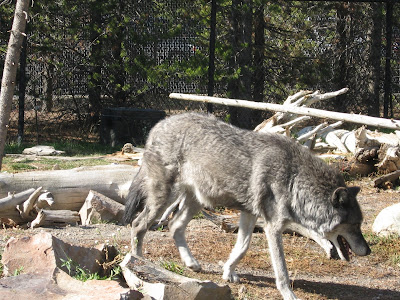If you have already read the blog about Jackson and the Tetons, you should go back to it and read a section that I added about the moose that we saw.
We did leave Jackson on Saturday, Oct 1st, and drove west thru some serious mountains - some of the grades were 10%, meaning
that it was a steep climb (at 40 MPH the engine was groaning and the fan was going full blast to keep the engine cool) or that we were heading down a steep decline (the truck's 'tow/haul' feature did an excellent job of keeping our speed under control).
Just on the other side of the mountains was Idaho and we then traveled north thu the eastern part of the state and then turned back east to go into Montana and West Yellowstone, where we found our CG. Nolan and Barbara were with us and they found their hotel.
That afternoon we visited the Grizzly & Wolf Discovery Center in town.
The Grizzly & Wolf Discovery Center offers every visitor to Yellowstone a chance to uniquely experience the world of grizzly bears and gray wolves. All the animals at the Center are unable to survive in the wild and serve as ambassadors for their wild counterparts.
This is the area for the wolves:
And this is the bear compound:
This guy was lying down at first but then decided to sit up - he has a good sized hole that he could sit up in and look around.
Some of it was fenced while part of it had a deep trench around it so it looked more natural. They are searching for food that has been put out for them.
Later we drove into the Park itself to see 'Old Faithful.'
As we got to the parking area, we saw alot of people coming back from the geyser. Apparently it had just finished doing its thing. Little did we know that it would be another 90 minutes before it spouts again!!
I just found this chart on the internet that helps explain the timing of the geyser.
Predicting Old Faithful:
The time to the next eruption, the interval, is predicted using the duration of the current eruption. The duration is timed from the first heavy surge which lifts water skyward at the start of the eruption until the last small splash above the cone at the very end. The longer the eruption lasts, the longer the interval until the next eruption. For instance, a 2 minute eruption results in an interval of about 55 minutes whereas a 4.5 minute eruption results in an interval of about 90 minutes. See the following table for more information.
It is not possible to predict more than one eruption in advance.
| Duration | 1.5 min | 2.0 min | 2.5 min | 3.0 min | 3.5 min | 4.0 min | 4.5 min | 5.0 min |
| Interval | 50 min | 57 min | 65 min | 71 min | 76 min | 82 min | 89 min | 95 min |
Our geyser was about 3.5 minutes long so I guess the next one would be in about 76 minutes. Anyway, here is what we saw:
This is the water run-off.
It is not the biggest or the most regular geyser in Yellowstone but it is the biggest regular geyser. Furthermore, it has been erupting in nearly the same fashion throughout the recorded history of the park.
Below is a map of the Upper Geyser basin showing the locations of some of the hundreds of geysers and hot springs in the basin.
On our way back to our CG/hotel, we stopped at this geyser:
You can walk out on a boardwalk and see the geysers and the pools of water. These next pictures show the run off into the river and the steam that it ceates due to the water being so hot. Notice how it stains the rocks.
Judy wanted a picture of some 'dude' on the boardwalk.
Here is another geyser.
Excelsior Geyser was the largest geyser in the world in the 1880s. Now it is just a very large crater that emits a copious amount of water. After nearly 100 years of inactivity, it had some minor eruptions in 1984.
These are just a few examples of geysers throughout the park. Many can be seen right along the road just steaming. There will be several more pictures in Day 2.



































No comments:
Post a Comment